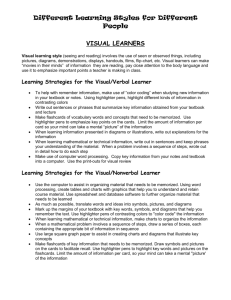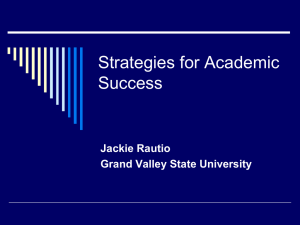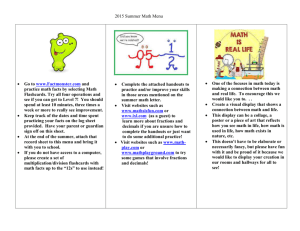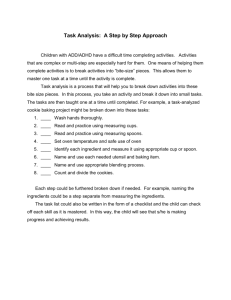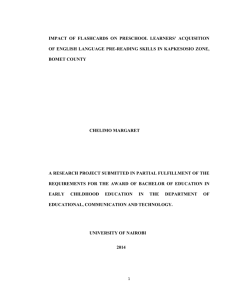Study Tips for Auditory Learners
advertisement
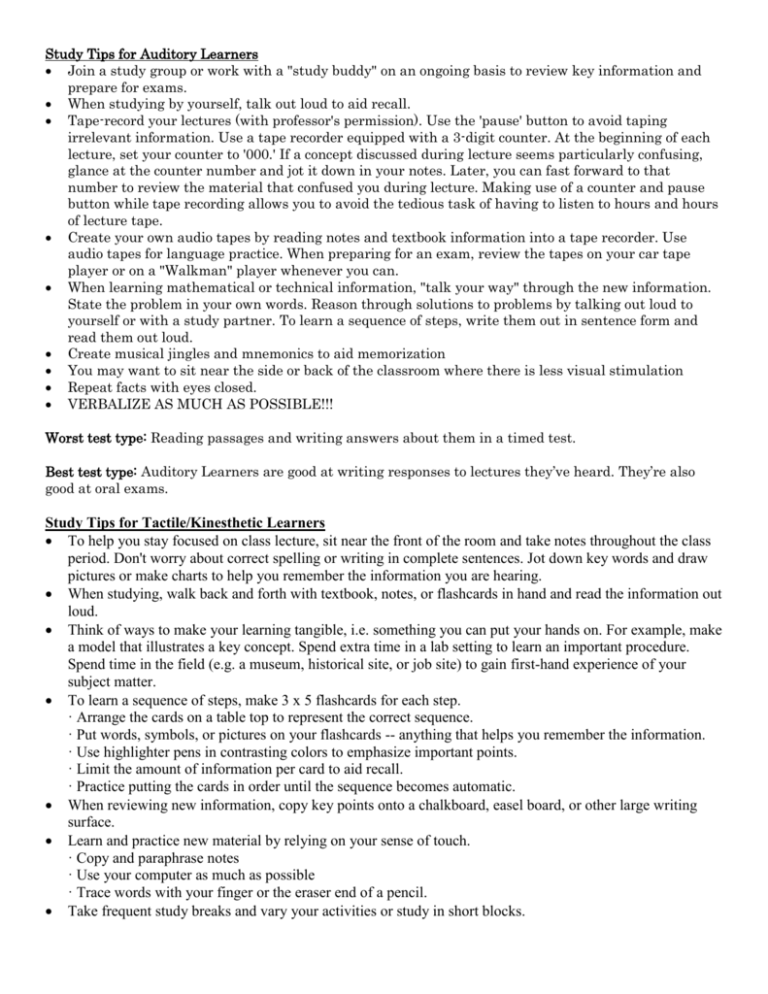
Study Tips for Auditory Learners Join a study group or work with a "study buddy" on an ongoing basis to review key information and prepare for exams. When studying by yourself, talk out loud to aid recall. Tape-record your lectures (with professor's permission). Use the 'pause' button to avoid taping irrelevant information. Use a tape recorder equipped with a 3-digit counter. At the beginning of each lecture, set your counter to '000.' If a concept discussed during lecture seems particularly confusing, glance at the counter number and jot it down in your notes. Later, you can fast forward to that number to review the material that confused you during lecture. Making use of a counter and pause button while tape recording allows you to avoid the tedious task of having to listen to hours and hours of lecture tape. Create your own audio tapes by reading notes and textbook information into a tape recorder. Use audio tapes for language practice. When preparing for an exam, review the tapes on your car tape player or on a "Walkman" player whenever you can. When learning mathematical or technical information, "talk your way" through the new information. State the problem in your own words. Reason through solutions to problems by talking out loud to yourself or with a study partner. To learn a sequence of steps, write them out in sentence form and read them out loud. Create musical jingles and mnemonics to aid memorization You may want to sit near the side or back of the classroom where there is less visual stimulation Repeat facts with eyes closed. VERBALIZE AS MUCH AS POSSIBLE!!! Worst test type: Reading passages and writing answers about them in a timed test. Best test type: Auditory Learners are good at writing responses to lectures they’ve heard. They’re also good at oral exams. Study Tips for Tactile/Kinesthetic Learners To help you stay focused on class lecture, sit near the front of the room and take notes throughout the class period. Don't worry about correct spelling or writing in complete sentences. Jot down key words and draw pictures or make charts to help you remember the information you are hearing. When studying, walk back and forth with textbook, notes, or flashcards in hand and read the information out loud. Think of ways to make your learning tangible, i.e. something you can put your hands on. For example, make a model that illustrates a key concept. Spend extra time in a lab setting to learn an important procedure. Spend time in the field (e.g. a museum, historical site, or job site) to gain first-hand experience of your subject matter. To learn a sequence of steps, make 3 x 5 flashcards for each step. · Arrange the cards on a table top to represent the correct sequence. · Put words, symbols, or pictures on your flashcards -- anything that helps you remember the information. · Use highlighter pens in contrasting colors to emphasize important points. · Limit the amount of information per card to aid recall. · Practice putting the cards in order until the sequence becomes automatic. When reviewing new information, copy key points onto a chalkboard, easel board, or other large writing surface. Learn and practice new material by relying on your sense of touch. · Copy and paraphrase notes · Use your computer as much as possible · Trace words with your finger or the eraser end of a pencil. Take frequent study breaks and vary your activities or study in short blocks. Make studying more physical—work at a standing desk, chew gum, pace while memorizing. read while on an exercise bike, mold a piece of clay, squeeze a tennis ball Use bright colors to highlight reading material Dress up your work space with posters and color Play music in the background while you study When reading, first skim through the whole thing to get a feel for what its about, then read the chapter carefully Worst Test Type: Long tests, essays. Best Test Type: Short definitions, fill-ins, multiple choice. Study Tips for Visual Learners Make flashcards of key information that needs to be memorized. Draw symbols and pictures on the cards to facilitate recall. Use highlighter pens to highlight key words and pictures on the flashcards. Limit the amount of information per card, so your mind can take a mental "picture' of the information. Mark up the margins of your textbook with key words, symbols, and diagrams that help you remember the text. Use highlighter pens of contrasting colors to "color code" the information. When learning mathematical or technical information, make charts to organize the information. When a mathematical problem involves a sequence of steps, draw a series of boxes, each containing the appropriate bit of information in sequence. Use large square graph paper to assist in creating charts and diagrams that illustrate key concepts. Use the computer to assist in organizing material that needs to be memorized. Using word processing, create tables and charts with graphics that help you to understand and retain course material. Use spreadsheet and database software to further organize material that needs to be learned. As much as possible, translate words and ideas into symbols, pictures, and diagrams. Draw a map of events in history or draw scientific process. Make outlines of everything! Copy what’s on the board. Ask the teacher to diagram. Diagram sentences! Take notes, make lists. Watch videos. Outline reading. Use highlighters, circle words, underline. Best Test Type for Visual Learners: Diagramming, reading maps, essays (if you’ve studied using an outline), showing a process Worst test type: Listen and respond tests
